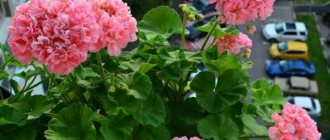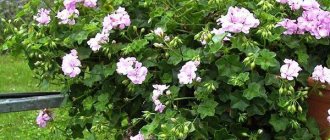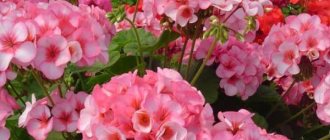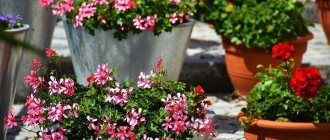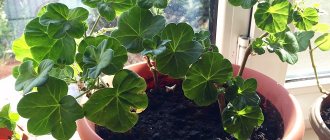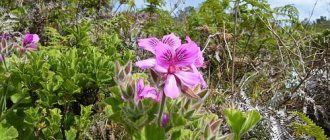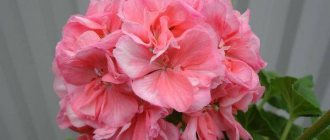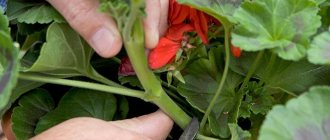Friends, pelargonium and geranium are different plants, although they belong to the same family. These are two daughters from the same Geraniev family - Pelargonium and Geranium. However, they are not similar in appearance, which happens with sisters. Let's figure out which sister lives in our house - pelargonium or geranium - what's the difference. Let's find out what the difference is in care and use, look at the photo. You can distinguish them by flowers, leaves, everything, but their seed pods are very similar. How similar the beaks of a stork and a crane are. After all, the flowers got their names from the Greek words pelargos - stork and geranos - crane.
Plants that bloom with large bright red, white and pink umbrellas on windowsills are not geraniums at all, as many are accustomed to believe. The correct name for indoor flowers is pelargonium. Real geranium is an unpretentious, frost-resistant, cute garden plant that overwinters well in natural conditions. Scientists confused two species of the same family in ancient times, back in the 18th century, and since then the confusion in the names has stuck, without at all spoiling the pleasure of flower gardens. And the difference or differences are important for understanding how to care for your pets.
These lines were written by Boris Pasternak, and it never occurs to anyone to insist on the name pelargonium in these delightfully cozy lines, much less look for differences or figure out what the difference is between pelargonium and geranium. Of course, time puts everything in its place, new varieties of geraniums and pelargonium are developed, and breeders name their creations correctly, often causing confusion among ordinary lovers: “Geranium or pelargonium? Why did the familiar geranium suddenly become pelargonium? Both genera belong to the Geranium family and have many species. However, it will not be possible to cross them with each other, since they are not genetically compatible. They differ in a number of characteristics characteristic of each genus.
How to distinguish pelargonium from geranium
You can tell them apart by their appearance; the sisters are too different.
Pelargonium
This is a southern flower, which in Russian climatic conditions can only exist as an indoor flower. In the summer it feels good on balconies and open verandas, but in the winter it must be brought indoors. Pelargonium (LINK) loves good lighting. If there is not enough of it, it stops blooming. However, direct sunlight of pelargonium, like geraniums, is contraindicated. Moderate watering is necessary; in waterlogged soil, the roots quickly begin to rot.
Pelargonium flowers have an irregular shape: the 2 upper petals are slightly larger than the 3 lower ones. They form large umbrellas of inflorescences. The different species come in many shades from white and pink to deep red. There are two-color varieties. But there are no blue, light blue or purple pelargoniums.
Geranium
The genus has a large number of species. Some, most often with blue and purple inflorescences, are wild and can be found in the forest or meadow. Garden varieties are distinguished by a variety of colors; there are white, pink, crimson and even almost black shades.
Geranium flowers consist of 5 or 8 radially symmetrical petals. They are often solitary or form a semi-umbrella inflorescence. They are very popular among gardeners because they are unpretentious, overwinter without shelter, and many bushes do not need to trim their leaves in the fall. In addition, they are very decorative even outside the flowering period.
Growing pelargonium at home
The plant is easy to care for and is suitable for beginning gardeners because it grows quickly, blooms beautifully, and reproduces easily.
Location/lighting
Pelargonium loves well-lit places and is not afraid of direct sunlight. Ventilation will protect it from overheating; it is also not afraid of drafts.
The plant is not afraid of changing places. It is recommended to periodically turn indoor geraniums with different sides towards the light so that the crown develops evenly.
Temperature
+20…+25 °C is the optimal temperature for caring for pelargonium at home.
In winter, some varieties, but not all, can be placed on a glazed balcony or veranda, where the air is heated to +5...+15 °C. It is important to protect the plant from drafts at this time.
Humidity
Pelargonium prefers dry air to humid air. So the conditions of most standard apartments are well suited for her. Plants that require humidifiers are bad neighbors for her.
It is not recommended to spray pelargonium. Drops of water remain on the fibers and can cause rotting, and if exposed to sunlight, act as a lens and cause a thermal burn.
Watering
Pelargonium is drought-resistant; the flower should be watered sparingly and only after the soil surface has dried.
Checking whether it is time to water is very simple. You need to touch the surface of the soil in the pot with your fingers. If the soil does not stick to your fingers, but crumbles, the plant can be watered.
Top dressing
The plant needs fertile, light, well-drained soil.
Abundant and long-lasting flowering will be ensured by regular feeding - once a week. You can add fertilizers in a minimum concentration (about 1:10 of the usual rate) with each watering.
Any liquid concentrates for flowering indoor plants are suitable. A passive method is also used - crystalline fertilizers, which are poured dry on top of the ground. Gradually dissolving during watering, they penetrate into the soil.
During the winter dormant period, feeding is stopped. In spring, fertilizers are used to increase green mass with a high content of potassium and nitrogen.
Transfer
Use a ready-made soil mixture, which is sold in flower shops, or prepare it yourself. To do this, take 2 parts of garden soil, peat, river sand, and 1 part of humus.
To aerate the soil, a drainage layer is placed at the bottom of the container.
After transplantation, the plant is not fed for a month, giving time to adapt. The new soil contains enough nutrients for development.
What is the difference in care between geranium and pelargonium
Garden geraniums are perennial plants.
- In winter, they do not need to be dug up or covered; they will overwinter wonderfully. At the end of the season or early spring, you will need to remove the wilted dried geranium greens; this is done once a year.
- Planted in soil with good water permeability. Planted in small groups. Geranium is a ground cover plant; it spreads well, and sometimes even too well, over an area and can cover large areas of land in a short time.
- They do not need fertilizing.
- Willingly settles in shade, partial shade and feels good in dry shade.
- Has a strong branched root system
Pelargonium is a completely different person to care for. This heat-loving child of the south grows outdoors as an annual.
- For the winter, it is either dug up and transferred to boxes for cool winter storage or thrown away. Pelargoniums are stored at a temperature of 5-7 degrees with limited light and sometimes moistening the soil.
- Flowering requires light. Zonal pelargonium grows and blooms well on balconies with a semi-shady location, when there is shade for less than half the day and sun the rest of the time.
- Needs regular feeding and moderate watering.
- It has a small fibrous root.
How to properly care?
- At the beginning of spring, the soil should be well loosened and fertilized with wood ash.
- Immediately after planting, geraniums are watered abundantly and often so that the roots begin to grow.
- Subsequently, the soil is moistened as needed - usually once every two to three days.
After watering, you need to loosen the soil again so that a dry crust does not form, which will interfere with air circulation. Watering must be done correctly - do not allow the soil to dry out. At the end of spring, you need to weed the area where the Geranium is planted quite often and thoroughly so that unnecessary grass does not clog the first shoots of the ornamental plant. - Once a season you need to prune old shoots to renew the entire plant. This will allow the plant not only to rejuvenate, but also, perhaps, to begin flowering again.
- It is advisable to maintain an average air temperature throughout the development of Robert's geranium; on very hot days, spray the flower so that its above-ground parts do not dry out.
- Air humidity should also be maintained at average levels.
- To prolong flowering a little, you need to fertilize the plant every two weeks. To do this, you can use both purchased drugs and home-made products.
Application difference
The difference in types also leads to different uses.
Geraniums
It is better to plant different types of garden geraniums in different parts of the garden in small groups. Together they create untidiness due to dissected leaves and small flowers. Applicable:
- As a ground cover, unpretentious perennial plant
- As background filling of flower garden voids
- Filling difficult dry areas of the garden in the shade
- For landscaping slopes, thanks to the tenacious, strong root system
Pelargoniums
- Like annuals in the garden
- As indoor plants (with lighting in winter)
- For landscaping open balconies and terraces
Use in landscape design
Pelargonium is a unique plant that is very popular among gardeners. The culture goes well with ornamental and cereal grasses. It can become either a framing part or a background element.
Garden Geranium beautifully fills gaps in flower beds, is used for decorative masonry, and the formation of exquisite compositions in the territory. The culture looks great in alpine hills, theme gardens, rockeries, and is combined with evergreen shrubs and large-leaf plants.
Types of geraniums
The magnificent perennial garden geranium actually has a magnificent lilac color and prefers sun and partial shade.
Gorgeous garden geranium
Dark brown geranium (Geranium Phaeum) - partial shade, shade
Geranium dark brown
Oxford geranium - partial shade, shade. Captures space quickly.
Geranium oxford
Blood red geranium - partial shade.
Blood red geranium
Meadow geranium
Types of pelargonium
- Pelargonium zonal
- Pelargonium royal
- Pelargonium angel
- Pelargonium ivy or ampelous
- Pelargonium fragrant
Pelargonium zonalis gets its name because of the colored zones on the leaves. Please note that these colored rings resemble balls. This is exactly what our grandmothers called their pelargoniums or “geraniums”. Colored stripes - zones can be pronounced or less pronounced, I noticed that this depends on the type of flower, light and temperature.
What is geranium?
In Germany, geranium is called Storchschnäbe (stork nose), in England and the USA Cranesbil (crane bird). This plant is widespread in all parts of Europe, Russia and the Caucasus. Geranium was domesticated in England starting in the mid-17th century; it appeared in Russia at the beginning of the 18th century. Then the plant spread widely during the development of the Caucasus at the beginning of the 19th century.
Propagated by seeds and vegetatively (varietal geraniums). There are herbaceous and semi-shrub species.
The soil is preferably loose, well-drained. Grows on acidic, slightly acidic and neutral soils. As a rule, geraniums are shade-tolerant and frost-resistant, adapt well to the vagaries of nature and grow well in open ground. Peduncles with 1–3 flowers, large and beautiful. The flowers are fully open in a plane with 5 evenly distributed petals. The petals are identical, almost round. There are 10 stamens, all developed, with anthers. The color is white, yellow, red, purple, blue and violet in different shades.
Spectacular varieties:
The leaves on the petioles of many species are soft-hairy.
In this case, dissection of geranium leaves:
- Palmate.
- Palmate.
- Pinnate with 3–5 leaflets (rare).
A member of the geranium family. The word "pelargonium" comes from the Greek "pelargos" - stork, since the fruits of geraniums look like a stork's beak.
Geranium was brought to Europe back in the 17th century from the Cape Colony. At first it was considered an aristocratic plant; it was bred in the greenhouses of rich mansions and suburban villas.
Since the middle of the 19th century, this flower has become increasingly popular; it was impossible to imagine a single garden or greenhouse in any country without it.
The selection of geraniums began in 1863, when the terry form was obtained in France. Many of the valuable varieties, which have not yet lost their importance, were bred by French flower growers, especially Lemoine and Sisley.
Now geranium is coming back into fashion. Flowers with flowers of a pure and bright tone, according to the modern school of architects, emphasize the beauty of the strict lines of new buildings. In the interior decoration of rooms where there is a lot of air and light, geranium greatly benefits from hanging vases and wall planters.
It requires much less care and maintenance than any other plant. In America there is even a society of lovers of this flower, uniting thousands of its ardent admirers. All species that are currently grown can be divided into several groups: zonal, variegated, fragrant, ivy-leaved, large-flowered.
The most common group is zonal. She has simple, semi-double and double flowers. The leaves of many varieties have a dark horseshoe-shaped border. There are about three hundred varieties. It is grown in greenhouses as a potted plant. Blooms from early spring to late autumn. It is placed on the balcony, in window boxes, as well as in open ground garden beds or flower beds, where it blooms profusely all summer.
Sometimes flowers are also used for cutting. In Russia, the most popular and widespread variety of zonal geranium has long been Meteor with scarlet flowers, abundant flowering and a light brown rim on the leaves. This first-class variety is widely cultivated in our country. Paul Krampel is considered the best variety in the world.
It is interesting that when Krampel first received this variety and realized that this was an extremely valuable variety, for several years, propagating it, he cut off all the inflorescences.
No visitor saw these plants in bloom until several greenhouses were filled with them. Then Krampel waited for flowering and invited buyers. This was in 1903. Every single plant was instantly sold for huge sums of money.
Variegated geranium is close to zonal, but during its selection the main attention was paid to obtaining beautifully colored leaves.
That’s why her flowers, as a rule, are simple, small and inconspicuous. Used as a border plant in flower beds and ridges. There are silver and white-edged varieties, varieties with leaves in bronze and yellow shades and many other variations.
The fragrant group of geraniums includes a large number of species whose leaves are aromatic, especially when rubbed. The flowers are simple and usually unattractive, with only one or two varieties being an exception.
At the beginning of the 19th century, oil began to be extracted from fragrant geranium. It has been grown in Russia since 1929. Large plantations are located in Abkhazia, Eastern Georgia, Armenia and Tajikistan. In the Middle Urals they are grown indoors.
Ivy-leaved, hanging (ampeloid) geraniums produce many simple, semi-double and double flowers of different colors (white, scarlet, pink, crimson). They are somewhat similar to the flowers of zonal geraniums. Ivy-leaved species are planted in hanging vases and baskets, wall planters, window boxes on balconies and loggias.
Large-flowered geraniums are often called English geraniums. The origin of this culture is unknown. It has been grown in England since the 17th century and is called royal or exhibition. In America, this druid is called Lady Washington. The flowers are large, brightly colored, and usually simple.
The plant develops normally only in a greenhouse and blooms once a year, usually in spring or early summer. In rooms it becomes very elongated, drops its lower leaves and, although the flowers are quite large, the plant itself becomes ugly. Therefore, it is better to grow this type of geranium in greenhouses and bring it home only during flowering.
Geranium is propagated by cuttings, less often by seeds. It takes 12-15 months from sowing to flowering. Crops often produce heterogeneous material, while cuttings flower 8-10 weeks after planting and always produce identical plants. Sowing seeds is most often resorted to when they want to obtain new varieties.
The seeds are collected before the capsules crack. They are placed in a paper bag, and in early spring they are sown rarely to a depth of 0.5 cm in a mixture of turf soil, high-moor peat and sand (2:1:1). The crops are moistened, covered with glass and shaded with a sheet of paper from direct sunlight. After 10-12 days at a temperature of about 15°, shoots appear.
In spring, summer and autumn (but usually in February-March and July-August) geraniums are propagated by cuttings. Zonal and ivy-leaved groups with autumn cuttings produce well-developed and abundantly flowering plants the next year, and with spring cuttings, flowering occurs in the same year, but the plants are somewhat smaller.
Large-flowered geranium, taken from cuttings in the spring, blooms the next year and forms superbly developed specimens. Propagated in autumn, it produces small plants, most often with one inflorescence. Variegated varieties are usually taken from cuttings in early spring, keeping the mother plants buried on the shelves of cold greenhouses all winter.
Fragrant geranium also takes root better in the spring. Cuttings with two or three internodes are cut with a sharp knife. Leaves are trimmed, except for the top ones. The cuttings are left to lie in a cold room for several hours until the cut is covered with a thin film.
It is customary for us to root cuttings in picking boxes or on racks in a layer of sand, and after rooting, plant them in pots. In many countries things are simpler. Pots with an earthen mixture are placed on the shelves, as for sowing, but in a different proportion (7: 3: 2).
Use a pointed peg to make a hole in the center. A little well-washed and dried river sand is poured into it and the cutting is planted, squeezing it tightly. Then water thoroughly. As the plants grow, the pots are placed looser. The cuttings take root at 18-20°C for 10-12 days, and after 4-5 weeks the roots completely entwine the earthen ball.
The plants are pinched to form a good bush, and in late April they are brought into free greenhouses, and at the end of May - beginning of June they are planted in a permanent place in flowerbeds, borders, boxes or large pots.
In room conditions, several cuttings are planted in pots (13-15 cm) with soil, which is covered with a 1-2 cm layer of well-washed river sand. After rooting, the cuttings are planted one at a time. The normal temperature for growing pelargoniums in a greenhouse is about 16°.
In winter it is kept at 6-8° and watered less often. Plants respond well to fertilizers and abundant watering, but do not tolerate waterlogging and stagnation of water. They bloom luxuriantly in a spacious pot or in a sunny place in open ground. Greenhouses with geraniums do not shade or are easily shaded only in the hottest summer. When growing in pots, use turf soil, high peat, humus and sand (3:1:2:1).
In rooms, geraniums tolerate winter worse than in a greenhouse. If possible, you should place pots with plants on windows facing south or southeast. The lower the temperature in the room, the better for them. In winter, keep the earth ball drier; when watering, water should not fall on the leaves and stems. Yellowed leaves are cut off, leaving a piece of the petiole; over time, it will fall off on its own.
Leaves should not be picked off, as this can lead to rotting of the stem. If the stem begins to rot, it is cut with a sharp knife to a healthy place, sprinkling the cut with charcoal. Plants that are too old bloom worse and require large containers, so you shouldn’t keep them in the room; it’s better to cut them out in the spring.
By autumn the cuttings will grow, become stronger, survive the winter well and bloom next spring. In the room, geranium develops normally until 5-6 years. When pruned in spring, the decorative effect lasts much longer.
Video on the topic:
Pelargonium (Geranium). Care and reproduction.
How to plant geraniums.
Tips for growing geraniums in your summer cottage.
What is pelargonium?
From the Greek Pelargos (stork), it also got its name from the shape of the ripe fruit. It is not for nothing that geranium and pelargonium come from the same geranium family. Unlike geraniums, pelargoniums are native to the hot climate of South Africa. This is a light-loving and drought-resistant plant. It is advisable to give her the brightest place in the apartment, the windows of which face south and southwest.
The flowers are collected in few- or many-flowered umbellate inflorescences. They are divided into bush (lush, low) and ampelous (creeping like a grapevine, ivy-leaved with long shoots). There are pelargoniums with bright lush inflorescences and there are fragrant ones with fragrant leaves.
The most popular bush pelargoniums:
- Zonal (border around the edge of the flower).
- Royal (large flowers).
Zonal varieties are the most common (75 thousand varieties) and are divided into:
Rosaceae;- tulip-shaped;
- Dianthus;
- stellate;
- cactus-like;
- deacons.
The most unusual type of pelargonium is succulent. They are divided into:
- Angular pelargonium.
- Humpbacked.
- Thick-stemmed.
- Fluffy-leaved.
- Meaty.
- The next one.
- Cortusifolia.
The benefits and harms of pelargonium for the home
Pelargonium is a popular indoor crop that is loved and appreciated by many gardeners. In addition to its decorative qualities, the shrub has medicinal properties, which have found their use in folk medicine:
- Many gardeners grow pelargonium for medicinal purposes, because with the help of products based on it, otitis media, colds, cataracts, migraines and even depression are treated.
- In addition, to improve overall health, inhaling the aroma that the shrub exudes is quite enough. The essential oils contained in the plant have a beneficial effect on the human nervous system, eliminate fatigue and relieve tension.
It is thanks to this property of essential oils that pelargonium is considered the keeper of the hearth and peace in the house. - The flower purifies the air, which promotes sound sleep, which is why many gardeners prefer to place it in bedrooms.
- Growing Kalachik in the house will help get rid of moths, mosquitoes, flies and other pests, because the smell it emits repels insects.
However, when choosing a shrub for your home, you should understand that it can bring not only benefits, but also harm to its owners:
- With extreme caution, you should bring pelargonium into a house where children or people prone to allergies live. The aroma of Kalachik is a strong allergen that can cause a runny nose, lacrimation and cough.
- The flower pot should be placed in a place inaccessible to animals, which may feast on its parts, as this can lead to poisoning.
What is the difference?
These two genera are very often confused and mistakenly called geranium; the most common fragrant plant in our homes with lush inflorescences, which is actually pelargonium. Discrepancies in the name of pelargonium began in the middle of the 18th century (in 1738), when in Holland the botanist Johannes Burman proposed to distinguish pelargonium into a separate genus.
In Sweden, the natural scientist Carl Linnaeus developed his own system of species classification and united both genera into a common group. The similarity between geranium and pelargonium is manifested in the structure of the seed capsule. It has a peculiar shape in the form of a crane's head and an open crane's beak.
Found in meadows, forests and swamps. The soils of the middle zone are suitable for it. Geranium has single flowers, in which there are 5 petals, less often 8. The petals are of the same shape, size, and color, arranged evenly, in the correct order. There are 10 stamens, all with anthers.
Colors in nature are blue and violet; selection: white, soft pink, crimson. Scarlet shades are extremely rare. Pelargonium comes from South Africa and is accustomed to the scorching rays and arid climate of the south. Therefore, pelargonium is more of a heat-loving indoor plant.
It has pronounced decorative properties and lush inflorescences. Does not tolerate wintering in open ground and is sensitive to cold. The flowers are collected in large zonular inflorescences. The petals are arranged asymmetrically, the top two are separate. There are 7 stamens, the rest are underdeveloped. Colors: white, soft pink, red. Two-color varieties have been bred, in which the petals have contrasting spots and strokes (rays).
Diseases and pests
Like many plants, pelargonium is susceptible to diseases and pests.:
- Gray mold on the leaves can appear from overwatering.
It is necessary to remove infected leaves, dry the plant and treat with a fungicide. When the root system or root collar rots, the plant most often dies. - With fungal diseases such as verticillium wilt and rust, preventive measures are used before the dormant period using fungicides.
- In the fight against whiteflies, mealybugs, aphids and thrips, insecticides are used and it is better to carry out treatment indoors.
On our website we have also prepared articles about why pelargonium leaves turn red, curl or dry, sometimes the leaves turn yellow and what to do in this case. Find out what to do if the plant does not bloom and why this happens here.
Pelargonium is a flowering plant that is suitable for growing on a windowsill and balcony, and even in open ground. Beautiful flowers will delight you throughout the summer, and the unique aroma will be present all year round.
Photo: what's the difference
In these photos you can see the difference between geranium and pelargonium:
What are the types and varieties of indoor and outdoor plants: name and description
See what types of geraniums there are:
| Type of geranium | Description | Varieties |
| Lesnaya | Bushy perennial plant up to 80 cm in height. The leaves are coarsely toothed and seven-parted. Numerous wide open flowers. | Birch lilac, Mayflower, Wannerii |
| Meadow | Light purple flowers with rounded petals. The leaves are strongly dissected and palmate. A few tall stems. | Floral pleno, Summer skys, Black beauty |
| Bolotnaya | High. Perennial, leaves five-parted, two large peduncles per inflorescence. Prefers sunny, damp places (water banks) | Palustre |
| Himalayan (garden, large-flowered) | Forms a low bush of 40–50 cm. Rounded leaves up to 10 cm, unevenly dissected into five lobes. Large flowers. | Gravetye, Plenum, Derrick Cook |
| Blood red | Spherical bush. Knobby, fleshy rhizome. In autumn, some of the leaves turn crimson-red, while others remain green all winter. | Striatum, Lancastriense, Prostratum |
| Renarda (gray, grassy) | Perennial with 1–2 stems 20–25 cm high. Olive-green leaves (6–9 cm), five-parted to half. Pale petals with brightly colored veins. | Zetterlund, Philip Vapelle |
| Magnificent (lush) | Hybrid of Georgian and flat-petalled geranium. Forms a lush bush 50–60 cm high. The leaves are serrated along the edges. | Mrs. Kendall Clark, Rosemoore, Lighter Schatten |
| Roberta | An annual plant 20–30 cm in height. Light green, strongly divided leaves. Abundant small (2 cm) pink flowers on long stems. | Robertianum |
| Large rhizomatous (Balkan) | A thick rhizome (diameter 1.5 cm) branches along the ground. Long-lived, forms a shrub up to 30 cm high. Bright green large (6–10 cm) leaves. Deeply dissected, elongated-rounded. | Spessart, Ingwersen's Variety, Ingwersen, Czakor, Variegata |
| Red-brown. | Shade-tolerant, bush-like (70–80 cm in height). The leaves are bluish, with a purple pattern in summer. The flowers are small (2 cm) and dark purple in color. | Samabor, Spring time, |
| Ash (gray, gray). | Low (10–15 cm) bush with gray-green rounded leaves with 5–7 lobes. Pale flowers with contrasting veins and a dark eye in the center. | Ballerina, Purpureum, Splendens |
| Georgian. | Grows in subalpine meadows. Forms a perennial bush 60–80 cm high. The leaves are round, the petals are wedge-shaped. | Ibericum, Jonsons Blue |
| Armenian (small-stamened, black-eyed). | Forms a perennial shrub up to 60 cm tall. Bright crimson flowers with an almost black eye. | Patricia |
| Flat-petalled. | Dense tall bush 60–70 cm, reaches 100 cm in diameter. Blue-green rounded leaves. The petals are wide wedge-shaped. | Platypetalum |
| Endrisa | Medium-height perennial bush (40–50 cm). Dark green leaves. Pink small (3–3.5 cm) flowers | Betty Catchpole, Beholder's Eye |
Botanical characteristics and history of occurrence
This variety is a representative of annual plants . Presented as an upright shrub with rather spreading shoots. The stems also grow straight, reaching a height of about 20-30 centimeters, all of them are covered with a hard pile consisting of red glandular hairs. It is thanks to this pile that the stems appear a little reddish and fluffy.
This is a plant of natural origin. It grows in deciduous forests and ravines of Central and Eastern Europe, as well as in some regions of Russia, preferring damp and shaded areas. You can find Robert's geranium on the wet rocks of the Caucasus and the alpine meadows of the Himalayas. Sometimes it can grow in the cracks of trees that are covered with moss.
Planting pelargonium
Despite the fact that pelargonium is a perennial plant, it freezes in winter in the middle zone, so there are subtleties in its cultivation.
In order for pelargonium to bloom all summer, it needs to create appropriate conditions. Choose soil with a slightly acidic or neutral reaction; its composition must be light; the presence of peat and river sand has a beneficial effect on the plant. In the fall, when you dig up the soil, add humus and mineral fertilizers.
Pelargonium can grow in the garden, but it is better for it to winter at home
Pelargonium takes well to watering, so you need to water it moderately and not allow the soil to dry out. Although it can tolerate drought normally.
But it’s better not to plant it in open sun either: the optimal temperature for growth and development of pelargonium is +15°C, so the semi-sunny side is considered the best, or it will still have to be shaded.
Depending on the species, pelargonium has a number of individual characteristics, but the principles of planting and care are largely the same. To root green cuttings in the garden, you need to plant them in a mixture of peat and river sand. But you can also root at home using perlite.
Seed requirements
In order for pelargonium seedlings to sprout and develop successfully, it is necessary to select high-quality planting material. The seeds should be brown, oblong in shape and always hard. Other options for seeding material can either produce low-quality seedlings, or even leave the grower without a “harvest.” To avoid such troubles, you should not buy seeds at the market or in supermarkets. For this purpose, it is better to visit a specialized store, the quality of the goods in which will be guaranteed to be high. Good seeds are sold ready for sowing, so you don’t have to do any complicated manipulations to get them to germinate.
What geranium seeds look like - photo
Large size garden geranium seeds. They are hard, oblong in shape and brown in color. Next you can see in the photo what geranium seeds look like:
The seeds of indoor pelargonium are small, slightly elongated, shiny.
How to collect geranium seeds
If the plant is indoors, it is possible to obtain seeds only by pollinating the pelargonium yourself. To do this, pollen from the stamen of one flower is very carefully and carefully transferred to the pistil of another using tweezers, a toothpick or a cotton swab.
Soon a box will appear in the middle of the flower, which will gradually ripen, dry out and fall off. Next, how to collect pelargonium seeds is very simple and clear, but you should be warned that from such seed material plants will grow that will be inferior in color saturation to the mother’s.
Selection of pelargonium seeds
To avoid possible mistakes, you need to carefully select and prepare planting material. When choosing seeds, you should pay special attention to the following points:
- Color. High-quality pelargonium seeds have a rich brown color. Slight dullness and light tint are allowed.
- Form. The developed seeds are oblong, with slight depressions visible on their sides.
- Size. The planting material is quite large.
- Shell. Pelargonium seeds are characterized by a dense, leathery shell.
Also, when choosing planting material, pay attention not only to the beauty, shape and richness of the shade of the buds, but also to the maintenance conditions that the flower will need to provide for healthy growth and full flowering. If creating the appropriate conditions necessary for growing the selected type of geranium from seeds at home seems too difficult to you, it is better to opt for another variety of pelargonium.
Processing of seed material
As already mentioned, geranium seeds have a dense shell, which makes their germination difficult. Sometimes you have to wait quite a long time for germination, but the seeds still do not germinate. The reason for failure is improper seed treatment before planting or lack thereof.
Before planting, geranium seeds must undergo scarification - a procedure to remove the dense film. It is not difficult to carry out this procedure yourself. To do this you will need fine sandpaper. With its help, only the top dense layer is removed from the seeds, and no deep tears remain.
After this, they are treated with phytohormones (“Epin”, “Zircon”) and soaked in warm water for several hours.
You need to process each seed separately, rubbing it on sandpaper several times.
If you purchased high-quality seeds from a well-known company, or, for example, bought seeds from China, then you will not need to carry out complex preparatory procedures. All you need in this case is to store the planting material in a dry, dark place, protected from insects and sunlight.
If the packaging with seeds indicates that the material is not prepared for planting, or you have some doubts about the quality of preparation, additional processing will be required. To do this, use phytohormones (“Epinom”, “Zirconom”), after which the seedlings are soaked in warm water for several hours. Carrying out such procedures helps accelerate seed germination and improves the quality of seedlings.
When to plant seeds
If you have the necessary lighting, you can plant seeds at any time of the year. It is still better if the plant has natural light and sunlight. Therefore, the best option is considered to be the period from November to April.
Essentially, during this time, the length of the day gradually increases, which helps the growing seedlings also get used to the duration of light.
Pelargonium propagation
Pelargonium propagates by seeds and vegetatively (green cuttings).
- Many hobbyists root cuttings directly in winter; to do this, plant the cuttings in sand or perlite and moisten them. Cuttings are taken from mother plants overwintering at home at a temperature not exceeding +12°C. Cuttings are rooted in January at +16°C; already at this temperature the plant begins to take root. Next, the temperature is increased to +20°C, the formation of a full-fledged root system of the cutting occurs in about 3 weeks. When the root system is formed, transplant the young plants into small pots and take them to the greenhouse for hardening and growing. It can also be grown on a window.
Pelargonium cuttings are usually rooted in perlite, but they root well just in water
- Seeds should also be sown in containers in winter, from December to February, the soil mixture should consist of river sand and peat or peat alone. You will have to wait about 3 weeks for germination, during which time the soil must be regularly moistened. It is advisable to cover the top of the container with film. When the seedlings reach the stage of three true leaves, they are planted in separate containers. To make the plant more bushy, pinch it above the 6th leaf.
Where and how to plant it?
Planting garden pelargonium must begin with:
- preparation of planting material;
- choosing a landing site;
- planting pit equipment.
Preparation of cuttings
For planting, cuttings are used and planted in early June. Before planting, prepare the cuttings:
- choose green young shoots;
- remove the foliage and peduncle, leaving a couple of leaves on top;
- cutting length 5 cm;
- the cutting must have an acute cutting angle;
- the sections are treated with charcoal;
- Dry the sections for 2-3 hours.
Prepared cuttings can be rooted in water and then sent into the ground, or directly into the ground.
Location
- Choose open areas with diffused light and light partial shade.
- The soil at the planting site must be fertile, light and drainable. Soil with peat, humus or sand is ideal.
- Dense loamy or clay soil is not suitable for planting. It should be neutral or slightly sour.
- There should be no stagnant water on the site.
Planting pits
- Make drainage at the bottom.
- Pour soil on top.
- Place the seedling in the hole.
- Compact the soil around the seedling.
- Water and mulch the soil.
Types of pelargonium
The pelargonium genus has about 250 species that grow in South Africa. In our country, the most common ones, which have given rise to many varieties and hybrids, are the zonal plant and the ivy leaf plant.
Our market will help you choose pelargonium seeds and seedlings - an illustrated catalog of products from various online stores.
Pelargonium zonale
The contoured, patterned leaves of this perennial pelargonium can be light or dark green. A number of well-known sources say that this species is annual, but I would say that it simply does not overwinter in open ground. I dig it up and replant it in a pot, so even in winter my pelargonium blooms.
Pelargonium zonal
In winter, queen cells are stored at temperatures up to +23°C. When the plant fades, the shoots are cut to 10 cm and the container is moved to a bright, cool room with a temperature no higher than +15°C. By the way, this species tolerates drought well and has many new interesting varieties and hybrids. Bright colors (white, red, dark red, crimson, pink) and spherical umbrella-shaped inflorescences with simple or double flowers are why gardeners love this pelargonium so much. Zonal pelargonium can decorate not only a window sill, but also hanging baskets, tubs and containers, flower beds, borders or borders.
Pelargonium of this species does not tolerate excess moisture, can withstand temperatures down to -6°C, and at temperatures below +9°C the leaves turn yellow. Varieties and hybrids affect the height of the plant: for example, the 'Meteor' is short, so it is used for borders. And in the 'Rocky Mountain' you can find vigorous-growing varieties, and also in unusual shades. Medium-sized unusual varieties
- 'Rumba Fire' - fiery, I would say, bordering on the "poisonous" saturation of the red color, attracts attention from any point of view.
Pelargonium zonal
- 'Bravo Pastel' - petals are white, gradually turning into pink, with a delicate crimson eye
Pelargonium zonalis 'Bravo Pastel'
Brief description of cultivation
- Bloom . Geranium can bloom throughout the year.
- Illumination . It needs a lot of bright light, so a south-facing window sill is perfect for the flower.
- Temperature regime . During the growing season, the flower grows normally at normal room temperature. In this case, during the rest period the air temperature should be about 15 degrees.
- Watering . During the growing season, the bush is provided with abundant watering, and it is carried out immediately after the top layer of the substrate in the pot has dried. In winter, the plant is not watered.
- Air humidity . It grows normally at the level of air humidity that is typical for residential premises.
- Fertilizer . Geraniums are fed from the last days of March to the second half of November twice a month, using complex mineral fertilizer for flowering indoor plants.
- Rest period . From the end of November until the first days of spring.
- Transplant . The procedure is carried out only if necessary, when the root system becomes very crowded in the pot. It is recommended to transplant at the beginning of the growing season.
- Trimming . It is held every autumn. To do this, you need to shorten all the stems so that 6 or 7 leaf blades remain on them.
- Pinching . It is recommended to pinch all shoots above the fourth or fifth leaf blade.
- Reproduction . Seeds and cuttings.
- Pests . Whiteflies, aphids and spider mites.
- Diseases . Botrytis, leaf spot, bacteriosis, black rot, rust, root rot and viruses.
The pelargonium plant is part of the Geranium family and is native to South Africa. This genus unites about 400 forms and species of pelargonium, and among them there are both annuals and perennials. In European countries, geraniums began to be grown at the end of the 15th century or the beginning of the 16th century. Flowering geranium, or pelargonium, is related to common geranium and meadow geranium. Those species that are cultivated at home have been united by experts under the general name “indoor geranium”.
